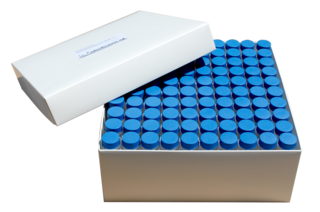Freezing samples in glass vials
Do commonly available laboratory glass vials filled with sample solution withstand a freezing process?
Yes, provided certain principles are considered.
The autosampler and storage vials from infochroma ag are manufactured from borosilicate glass. Borosilicate glass can be cooled to the maximum freezing temperature possible. It is the accessory used in combination with the vials (caps, seals) which define the maximum freezing temperature.
Cylindrical vials such as the Vµ-Vials of infochroma and vials with a light neck narrowing are better suited than vials with a considerable neck narrowing. Besides the geometry of the vial, the properties of the accessory (eg. screw caps) is to be taken into consideration, as already mentioned. This is especially true for the successful longterm storage of samples at a low temperature of -80 °C. The short term freezing of samples (at about - 4 °C) usually causes no problems.
Watch the expansion of the sample during the cooling process
Generally the content, in this case the sample, has a higher thermal expansion coefficient than the borosilicate glass of the laboratory vial. Because of this volume expansion, only ⅔ to maximum ¾ of the total volume of the vial should be filled. If disregarded, the liquid does not have enough space to expand during the freezing process. Filled to the max, the closed vial may burst because of the increasing pressure inside.
Less problematic than aqueous are organic substances as these expand less in the freezing process.
In any case it is advisable to monitor the expansion of the content by freezing the sample in a gradual process. Keep the vial in a slanting position (approx. 45°) during freezing as this increases the surface area.
Put the vials in a plastic rack or a storage box for freezing
For freezing and defrosting, it is recommended to put the vials either in a plastic rack, a plastic storage box or the infochroma sleeve box made from high quality cardboard (packaging of our storage and septum vials).
The sleeve box should be put on a grid or a corrugated surface to preclude the cardboard from soaking up condensation occurring during defrosting. Our sleeve boxes withstand three to four freezing/defrosting cycles.
Gradual and consistent defrosting
Shock defrosting could cause the glass vials to burst. Gradual defrosting is recommended.
Vials from borosilicate glass may be immersed in a liquid bath for defrosting but the temperature difference should not exceed 100 °C. Note that mechanical faults in the glass surface such as deep scratches may reduce the thermal shock endurance considerably.
Never put a glass vial into direct sunlight nor in an oven nor on metal nor stone for defrosting.
The frozen material should defrost evenly all round. Defrosting from the top is possible. Thus the surface liquifies which is where the material has space to expand.
However, it is best to let the vials defrost slowly at room temperature sitting in a plastic rack or a storage box. If an individual vial from a batch should be defrosted, it is best put on a plastic or wooden surface.
During the defrosting process, the vials should not be moved. Especially at the beginning of the defrosting process, when the vials are still very cold, they may stick to the surface and thus may burst when moved. Also avoid a draught as this may cause the material to thaw unevenly which leads to an uneven expansion of the content, which again may cause breakage.
Storing samples at temperatures as low as -80 °C over a long period of time
A major prerequisite for the ideal storage of samples is the impermeability of the vial regardless if the vial is stored in ambient temperature or in the freezer.
The bigger the actual volume of the vial in comparison to the opening of the vial head the better. Use screw or crimp vials, snap/cap vials are not rcommended. Closed-top caps are more reliable than open-top caps.
Don’t forget that the cap material reacts differently in the freezing and defrosting process than glass and has other temperature limits.
In this sense the cap is the crucial factor.
While aluminium crimp caps cause no problem at freezing temperature, common screw caps are usually made from polypropylene which turns brittle at a temperature below 0 °C and may chip. On the other hand, many food packagings which can be used for freezing are made from polypropylene.
Depending on the composition of the polypropylene, it withstands temperatures to -40 °C. Caps made from glassfibre enforced polyamide from the infochroma portfolio, should withstand -40 °C without problem.
Also consider the septum which lines the caps. A rubber septum can be used to about -40 °C while a silicone septum can be used to about -60 °C.
A representative test is recommended
For all these reasons, we recommend to run a representative test prior to storing a large number of samples in the freezer: best over several freezing and defrosting cycles.

